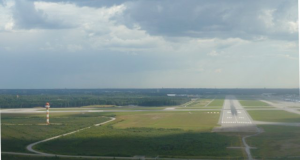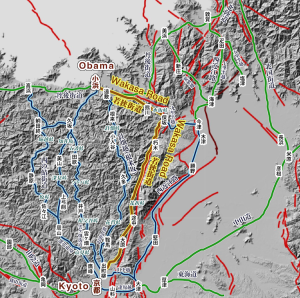1.3 Most of the Earth is free from earthquakes
*The contents may be subject to change without prior notice.
K. Z. Nanjo and K. Oike
NaDiR, Global Center for Asian and Regional Research, University of Shizuoka
World maps (Fig. 1-1 and Fig. 1-2) show that many earthquake-free areas lie far from tectonic plate boundaries. These areas are located on craton, the old and stable part of a continent. Take Finland, for example. Imagine you are in the airport in Helsinki, the capital of Finland, and look around. All you can see is a vast expanse of flat land in all directions (Fig. 1-8). Finland, the home of Moomin, is known as a country of forests and lakes, with forests in slightly higher regions and lakes in lower regions, with the rest of the country being flat. The country sits on old, solid ground, which is far from tectonic plate boundaries and thus has undergone no geologic activity since it was formed billions of years ago. For this reason, Finland has seldom experienced earthquakes.

Fig. 1-8: The horizon seen from the airport in Helsinki (Oike, 2011) (1).
Next, consider Stockholm, the capital of Sweden that borders Finland, renowned for holding the Nobel Prize awards every year. As this city sits on old and solid rocky ground, a way to break rocks was needed to develop the city, and so dynamite was invented by a Swedish scientist, Alfred Nobel. This invention earned him a fortune, which he left to found the Nobel Prize. Thus, the craton indirectly contributed to the founding of the Nobel Prize.
Unlike these areas on the stable craton, Japan is located in a seismically active zone called the deformation belt. When an earthquake strikes, the ground breaks, landslides occur, and masses of earth and sand move down. They are exposed to wind and rain, flow into rivers, and cover the plains and basins. Characteristically, this is what happens in a deformation belt. Flat land in a deformation belt is made of earth and sand.
Another characteristic of a deformation belt is that routes developed along active faults. In Dunhuang, China, for example, groundwater that welled up from deep underground along the cracks of the active fault formed oases, and so the Silk Road developed along these oases (Fig. 1-9). Japan also has historical routes along active faults, including the “Salt Road” (Shio-no-Michi in Japanese) along the Itoigawa-Shizuoka Tectonic Line, a major active fault zone (a cluster of parallel active faults) in Japan, which was used to transport salt and marine products to inland areas, and the “Mackerel Road” (Saba Kaido in Japanese) along the Hanaore Fault, an active fault, through which mackerel were brought from Fukui located on the Sea of Japan coast to Kyoto (Fig. 1-10). In addition, along active faults the land is lower with less variation in altitude, making it easier to travel on foot.

Fig. 1-9: The Silk Road running between the mountain range and plains near Dunhuang. This figure was modified from Oike (1989) (2).

Fig. 1-10: Mackerel Road and active faults. The red lines indicate active faults and other lines are routes. There are several routes between Obama and Kyoto. While all of them are called “Mackerel Road,” this name specifically refers to the Wakasa Road, the most traveled among them. The Wakasa Road runs along an active fault called the Hanaore Fault. To create this figure, Active Fault Database of Japan (3) and Saba Kaido (Wikipedia) (4) were used.
Sources and references
- Oike K., Deformation belts and stable continents in the world, Serialization “Lessons learnt from megaquakes that occurred in eastern Japan (2)”, ATOMOΣ (Journal of the Atomic Energy Society of Japan), 53(11), 739-741, 2011 (in Japanese), https://doi.org/10.3327/jaesjb.53.11_739
- Oike K., Active tectonic structure and seismic ruins in northwest China, Journal of Geography (Chigaku Zasshi), 98(7), Plate1-Plate4, 1989 (in Japanese), https://doi.org/10.5026/jgeography.98.7_Plate1
- National Institute of Advanced Industrial Science and Technology. 2025. Active Fault Database of Japan, 28 March 2025 version
- Saba Kaido (27 January 2025). In Wikipedia: The Free Encyclopedia (in Japanese)